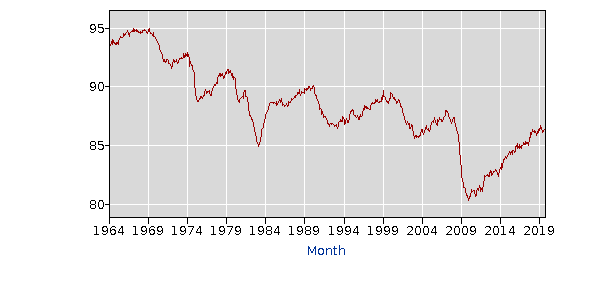December 09, 2019
NPR had a piece on how the percentage of prime-age men (ages 25 to 54) in the workforce remains low, despite the relatively strong labor market. While the basic point is true, there are a couple of important qualifications. First, this is not a new story. The share of men who are employed has been dropping for a half-century. The second point is that, contrary to what is implied in the piece, the decline in employment rates has occurred for men at all education levels.
On the first point, if we look at business cycle peaks, we have a decline in prime-age employment to population (EPOP) ratios of 9.1 percentage points, taking business cycle peaks, from 95.6 in 1967 to 86.5 percent in the November data. (This assumes we are at a business cycle peak, which may prove not to be true.) I use employment rates since the decision to look for work, and therefore be counted as part of the workforce, is affected by the structure of unemployment benefits, which has been frequently changed over this period.
Most of this drop took place prior to 1990 when the prime age male EPOP peaked at 90.0 percent, 5.6 percentage points below its 1967 peak. The drop in the remaining 29 years has been just 3.5 percentage points, as shown below.
Prime Age (ages 25-54) Male Employment to Population Ratios

Source: Bureau of Labor Statistics.
The other point is that the drop in EPOPs has occurred at all education levels, as is actually shown in a figure included in the piece. While the decline has been sharpest for less-educated workers, the figure shows a drop in EPOPs for prime-age men with a college degree of roughly five percentage points between 1975 and 2018. The drop for those with some college and with just a high school degree is larger (roughly 8.0 percentage points and 10.4 percentage points, respectively), but clearly, this drop cannot be explained by declining demand for workers with less education by itself.
In fact, if the story is that trade and technology have led to a decreased demand for workers with less skill, the implication is that it should have led to an increase in demand for workers with more skill. Other things equal, we would have expected that to mean an increased, or at least constant, EPOP for prime age men with college degrees.
In short, there clearly has been a drop in employment among prime age men, but this is not a new story, nor is it a simple story of changing skills demand in the labor market.







Comments